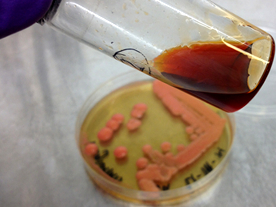Glyceride lipids are important for various industrial applications, especially in the production of biofuels. The majority of lipids for this are derived from edible plant oils, but the growing demand of energy cannot be met without seriously impacting food production. A promising alternative for glyceride feedstocks is the biotechnological production of lipids by oleaginous yeasts.
Christopher J. Chuck, University of Bath, UK, and colleagues investigated the lipid production of the oleaginous yeast Rhodotorula minuta on low-cost resources. They found that the lipid profile, which is comparable to rapeseed oil, did not change when grown at different environmental conditions. It contained 20 % palmitic acid, 5 % stearic acid, 60% oleic acid, and 15 % linolenic acid when produced on a range of different sugars and complex sugar mixtures. R. minuta also successfully produced lipids on thermochemically hydrolyzed food waste without any changes in the resulting lipid profile.
However, results obtained from depolymerized lignocellulose are less promising. The necessary acid-based pretreatment of lignocellulose for depolymerization leads to the emergence of furfurals and organic acids which are inhibitors of lipid synthesis in R. minuta.
On thermochemically hydrolyzed food waste, with no additional acids, R. minuta grew better than on the glucose control, whereas miscanthus and wheat straw were found to be unsuitable for lipid production with this yeast.
- Production of lipid from depolymerised lignocellulose using the biocontrol yeast,Rhodotorula minuta: The fatty acid profile remains stable irrespective of environmental conditions,
Lisa A. Sargeant, Matthew Mardell, Khalil M. Saad-Allah, Ali H. Hussein, Fraeya Whiffin, Fabio Santomauro, Christopher J. Chuck,
Europ. J. Lipid Sci. Technol. 2015.
DOI: 10.1002/ejlt.201500143




